No clue how to begin creating a shipping policy? This article looks at what a shipping policy should contain and how a shipping policy template can help you create one. Read more!
A shipping policy should be concise but detailed enough to inform your customers of everything they should be aware of regarding package shipping.
However, creating the document from scratch can be challenging, take time, and you can even forget to include critical information.
But a shipping policy template enables you to put together a detailed policy containing all the relevant information with minimal effort.
This article defines a shipping policy template, why you need it for your business, and what the document should have.
Let’s get right into it.
What Is a Shipping Policy?
A shipping policy is a document or web page that outlines your business’s shipping process to customers. The document includes the following information.
The shipping policy is a living document that you should regularly update to reflect changes in your business’s shipping terms and conditions.
If you are keen, you might have noticed most websites indicating the possibility of shipping delays due to COVID-19 when the pandemic was at its peak.
Even though many eCommerce websites displayed this information as banners, they updated it in the shipping policy documents.
The idea is to create a shipping policy that gives buyers all the relevant and updated information on shipping in one place.
Although not a legal requirement, the document helps you build trust with your customers and avoid issues/complaints.
Why Is a Shipping Policy Needed?
By informing the customer about all the shipping terms and conditions, a shipping policy helps manage customer expectations.
Also, if it takes a customer too long to figure out how much you charge for shipping, how long it takes, and other terms, you are more likely to lose the buyer.
The pricing part is crucial because customers are more likely to purchase from eCommerce stores with free or discounted shipping cost policies. You will have fewer conversions if you provide free shipping without a policy to indicate the deal.
Generally, a shipping policy benefits you in the following ways.
Prevents Misunderstandings
You can avoid customer confusion, WISMO questions, and misunderstandings by making the shipping information available beforehand. For instance, the shipping policy below makes the conditions for returning the product clear using simple language.
Example Shipping Policy:
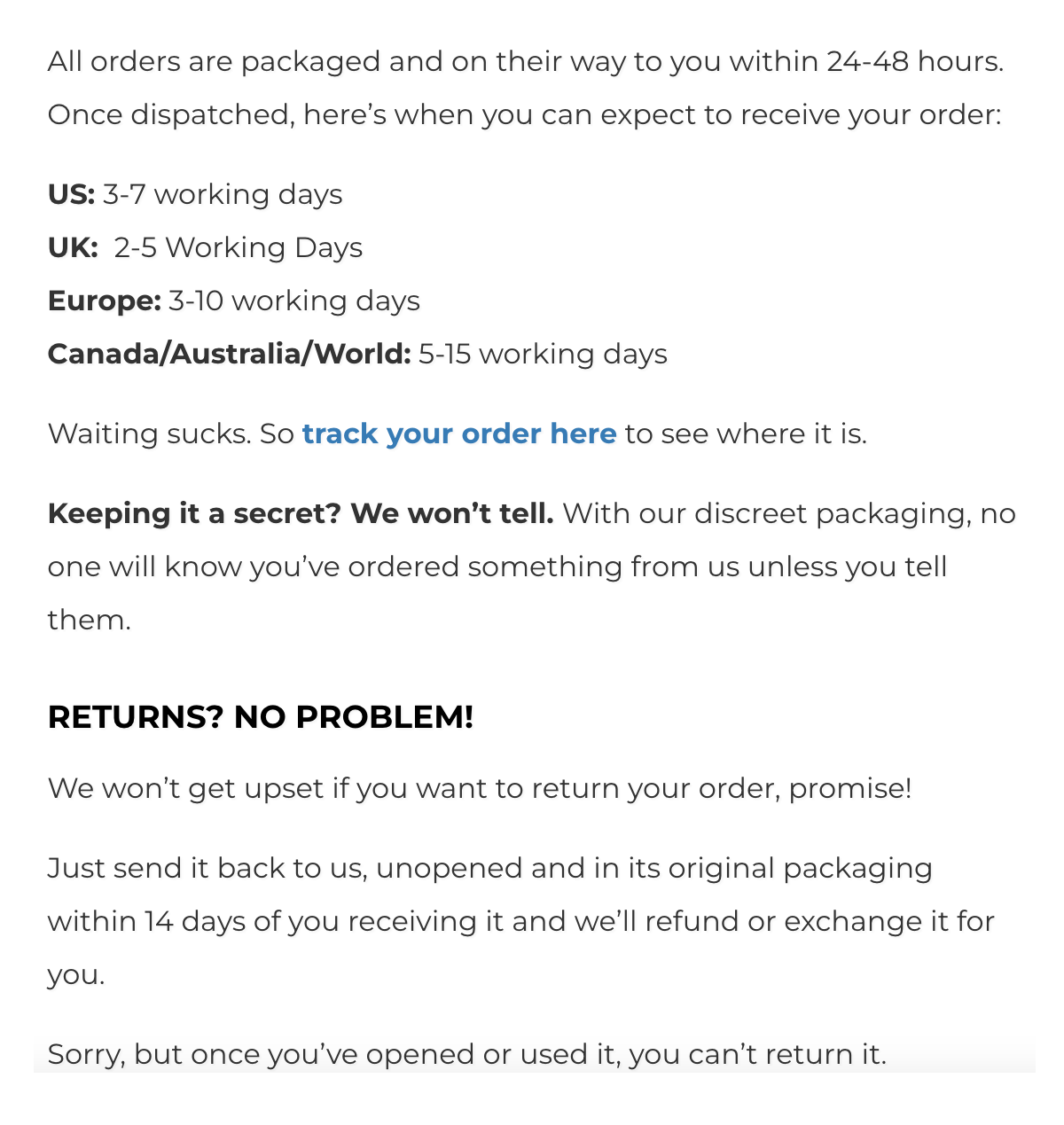
It minimizes the chances of reaching out to customer service or abandoning carts due to complex-to-understand conditions.
Keeps Customers Informed
Some customers can be demanding, wanting what they order almost immediately. A shipping policy lays out the details beforehand, keeping emotions out of the equation.
External factors beyond your control can cause delays, and the policy template should highlight how these variables will affect the delivery schedule.
External factors example:

An order tracking system can help ease the tension by showing the customer live location details of the package.
Sets Expectations for Exchanges, Refunds, and Returns
In rare cases, the package can get damaged along the way, or you can ship the wrong item size. The shipping policy should outline procedures for exchanging, returning, or refunding.
Remember, the more you share, the more you build trust and set expectations for handling the anomalies professionally and efficiently.
Protects Your Business from Lawsuits
Anomalies and late orders are annoying, and some customers can take legal action against your business.
But a shipping policy can help shield your enterprise from lawsuits if it lays out the possible shipping issues.
However, the document must have clear and precise wording to protect your business from legal action.
Besides lawsuits, complaints and poor reviews can hurt your sales. But if you abide by the contents of the policy document, you can point to it to exonerate your business from any “wrongdoing.”
What Is a Shipping Policy Template and How Does It Help?
A shipping policy template is a generic shipping policy document. It contains information and sections that simplify the creation of a customized shipping policy for your business.
Even the most generic ones should include at least the following information.
1. Shipping Costs
The policy template should have a section outlining the business’s shipping costs. This part should include how the rates vary depending on location, delivery time, and shipping method. For instance, you can use this template:
Shipping method: UPS
Shipping cost: $10.50
Estimated delivery time: 3-5 business days
Such a display of the shipping rate gives a high level of transparency that most customers appreciate. With this, they can get their total purchase cost quickly even before adding the product to the cart.
2. Delivery Times
The delivery time usually depends on the shipping method, and these two determine the shipping cost. You can get a template that breaks down this information in bullet points or a table.
If your business offers multiple delivery times and methods, it would be better to edit the template section into a table or get one that outlines this information in a table.
Here is an example.
Shipping Options & Delivery Times | Shipping Costs |
Standard (4-10 Business Days) | $5.99 |
Express (2-5 Business Days) | $15.99 |
Next Day Shipping | $23.99 |
International (10-14 Days) | $49.99 |
This information applies to orders placed before noon from Monday to Friday.
3. Shipping Restrictions
Some businesses don’t ship to all locations globally. State legislation can also restrict product shipping to specific parts of a country. Templates should have sections to highlight this restriction information.
For instance, Wine Country Gift Baskets cannot ship gift baskets to some US states. The company’s shipping policy lists areas with no restrictions and the specific wines they can deliver to the US states with wine shipping restrictions.
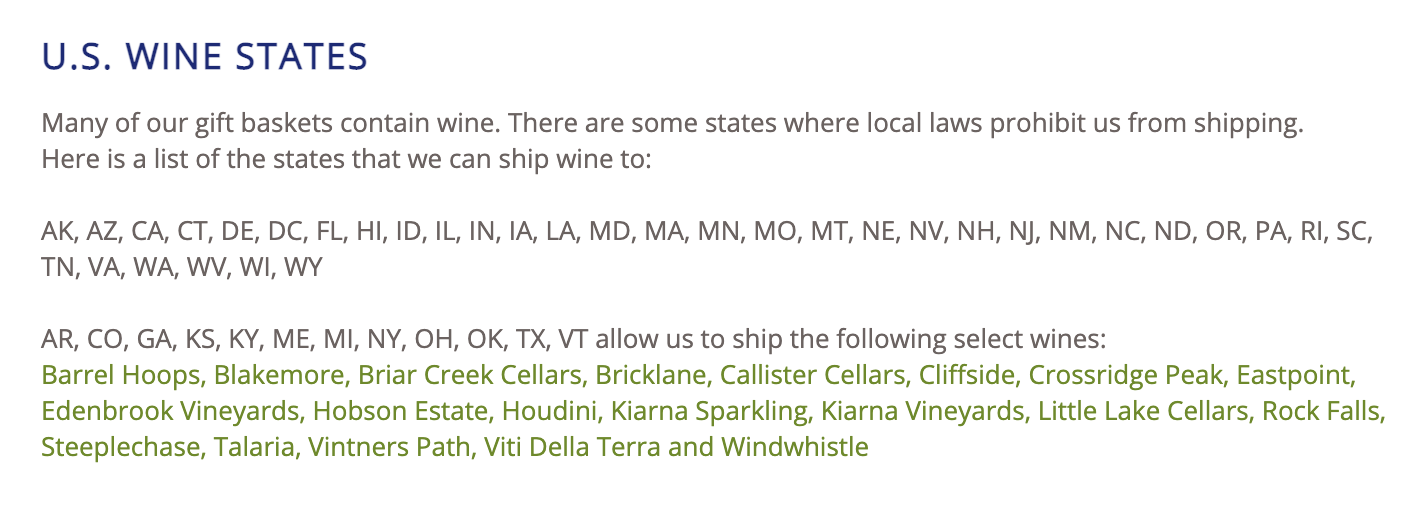
This section can also help your business avoid lawsuits from the bodies or governments enforcing the restriction laws.
4. Damages, Lost, or Missing Packages
Once a package leaves your business, it is no longer under your control. Anything can happen along the way.
Templates should contain this section plus some wordings to guide you on how to craft a personalized policy on damaged, missing, or lost packages.
The section information creates peace of mind in case of such incidents and assures customers of how you will handle the situation.
5. International Shipping Information
International shipping has more variables than domestic shipping. Therefore, it deserves a specific section to detail how the package(s) will cross borders to the final destination.
For instance, you should include:
This section is not necessary if you don’t do international shipping.
6. Return and Exchange Information
A detailed breakdown of how your business handles returns and exchanges is vital in a shipping policy template.
Here’s an example.

It should define the following information.
However, you can create a separate shipping-and-returns policy if you provide a money-back guarantee.
7. Company Information
Lastly, the shipping policy template should have your business’s information, such as the company logo and contact information. This data should assist the customers if they need to contact you or your representatives for further clarification.
Shipping Policy Examples Analyzed
Here are some shipping policy examples.
Wine Country Gift Baskets
Wine Country Gift Baskets has a detailed but brief shipping policy for eCommerce.
It includes the US shipping cut-off times, US shipping methods, shipments to Canada, international delivery, delivery service delays, and a returns policy.
Here’s the policy itself.
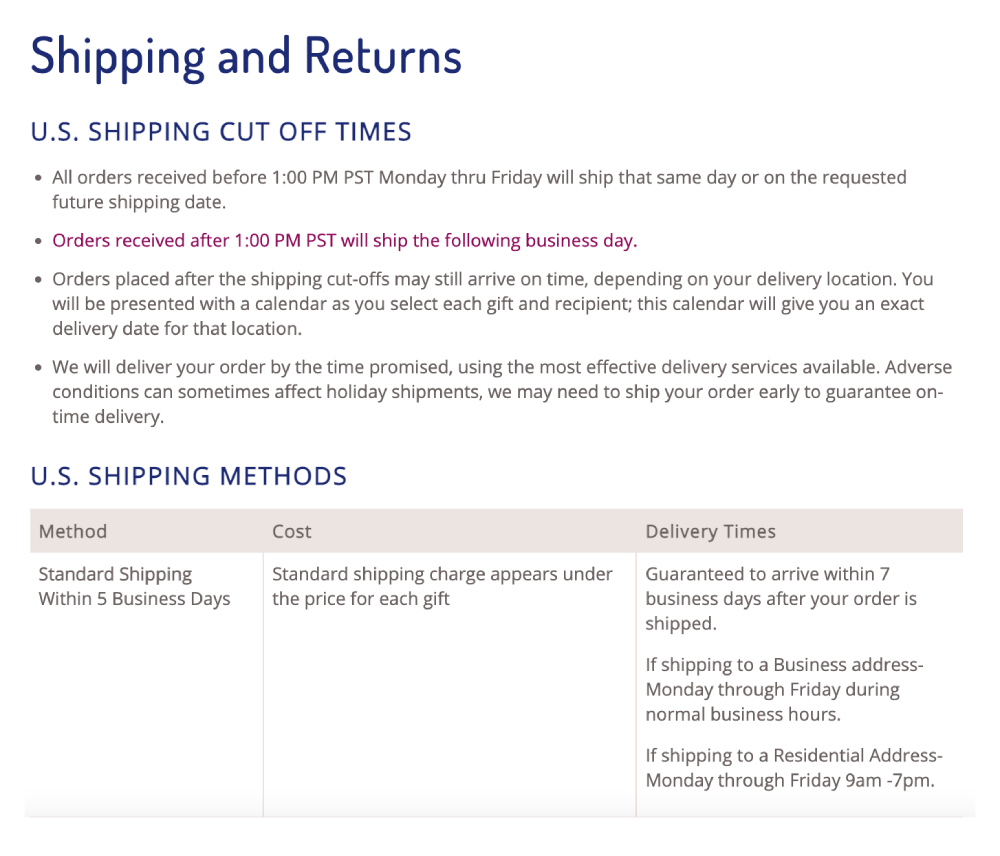
Even though it contains a lot of text, the company included tables, a map, and bullet points to make the policy skimmable.
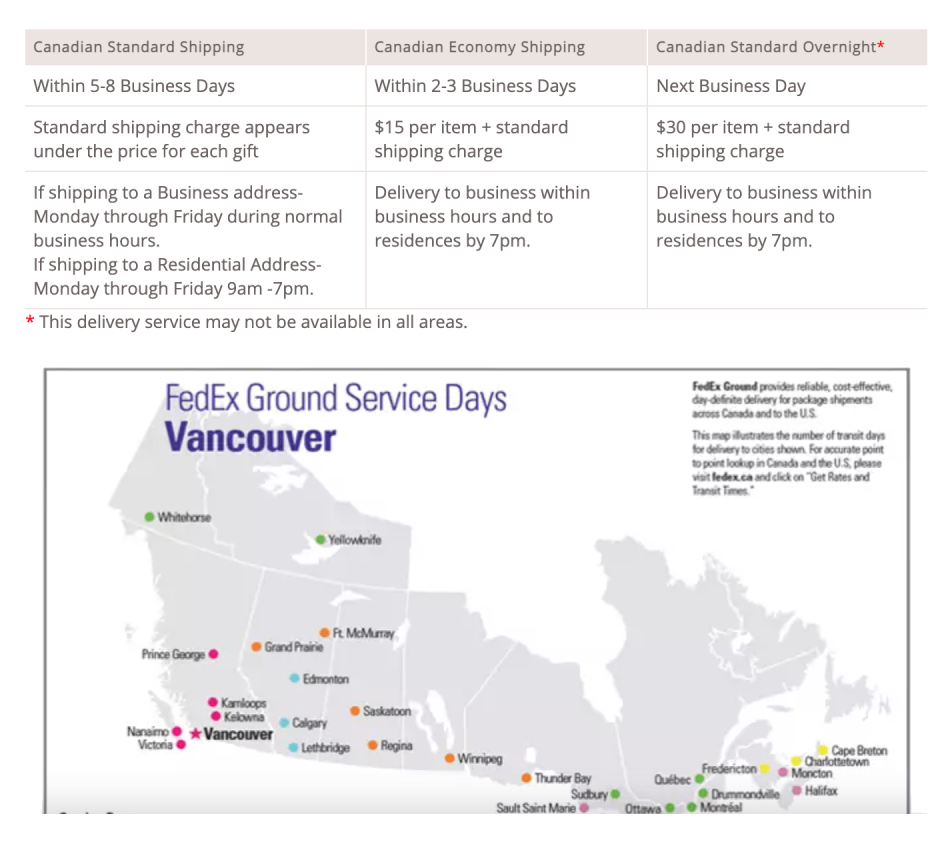
Your Super
Your Super is an eCommerce brand dealing with superfoods.
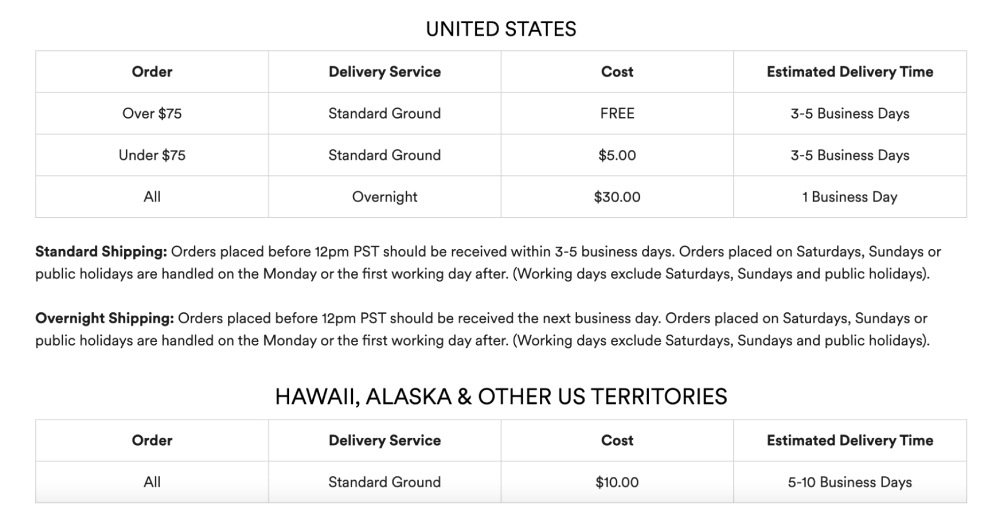
The company ships its merchandise primarily to customers in the US. Therefore, the company’s shipping policy describes the conditions for shipping to the US, Alaska, Hawaii, and other US territories.
The company has a separate website with a different shipping policy for fulfilling orders to other parts of the world.
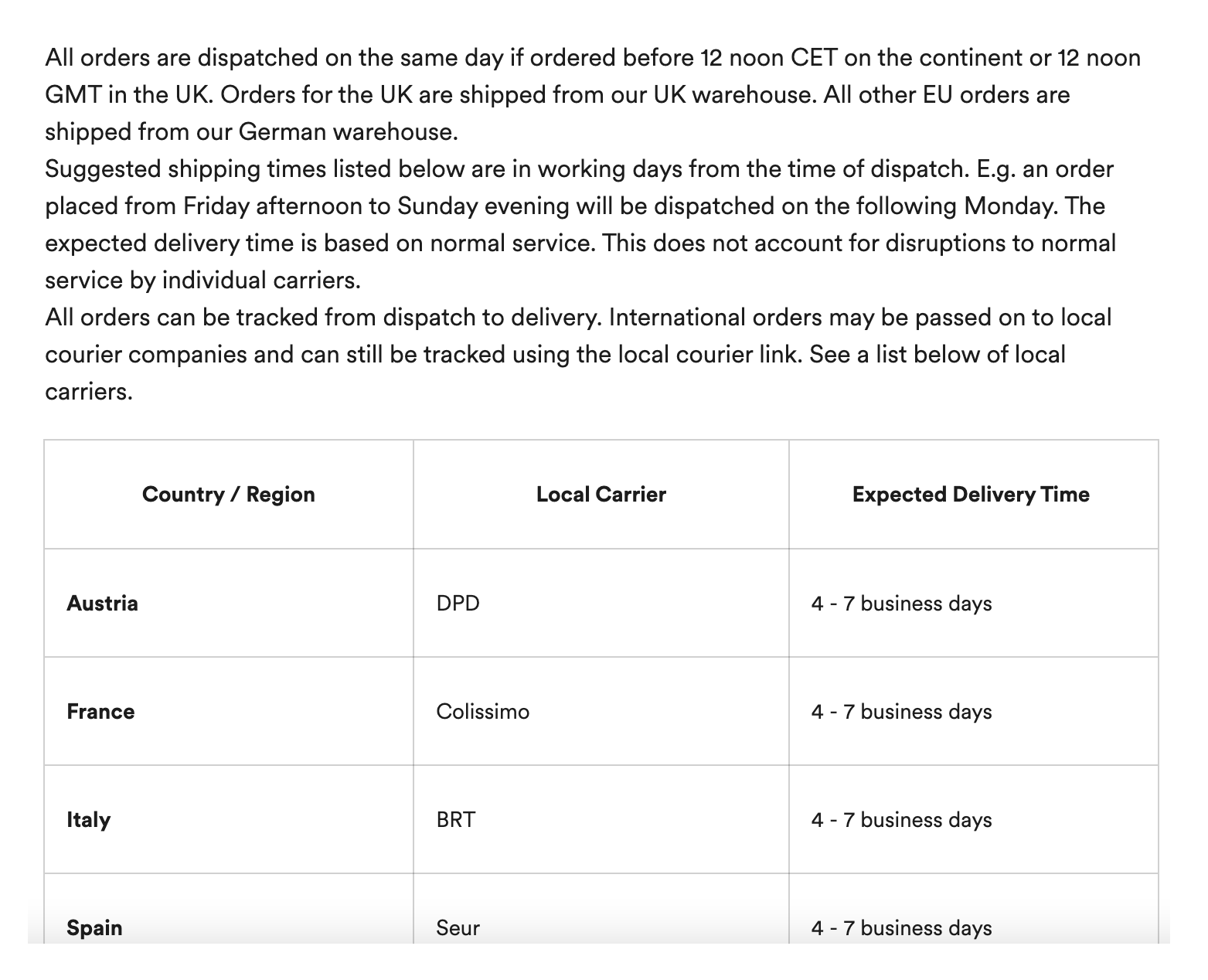
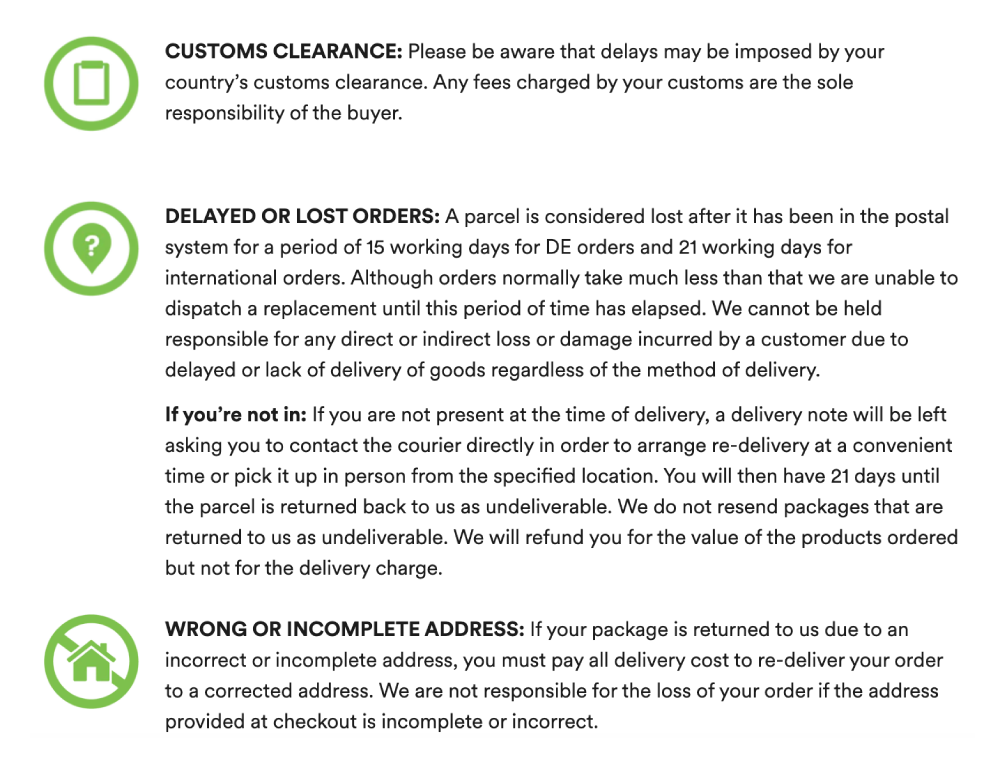
Organic Olivia
This health and wellness brand took a different approach regarding displaying its shipping policy.
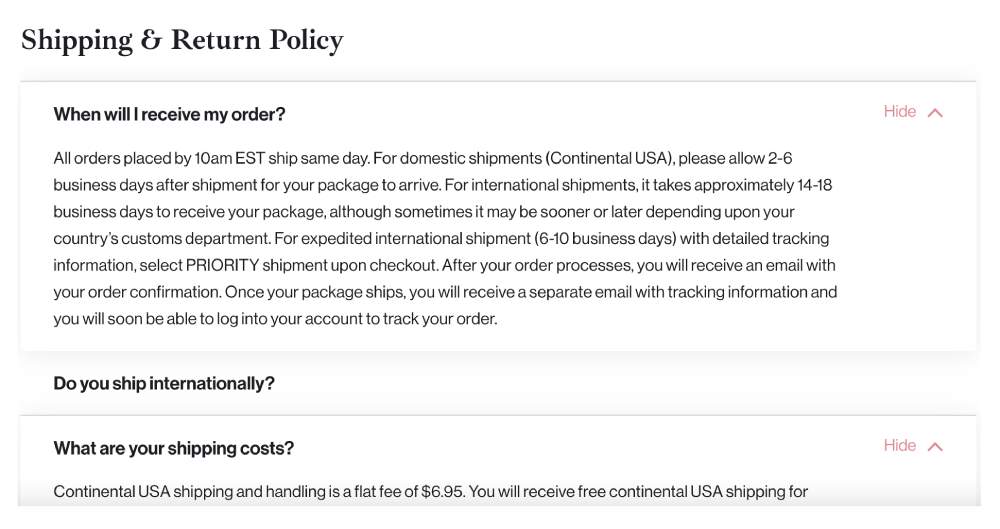
Instead of a regular webpage document, the brand has an FAQ policy section with answers to the shipping questions in drop-down menus.
eBay
eBay is not a regular eCommerce website. It is a marketplace that connects buyers and sellers. Therefore, its shipping policy stipulates what sellers should and should not do.
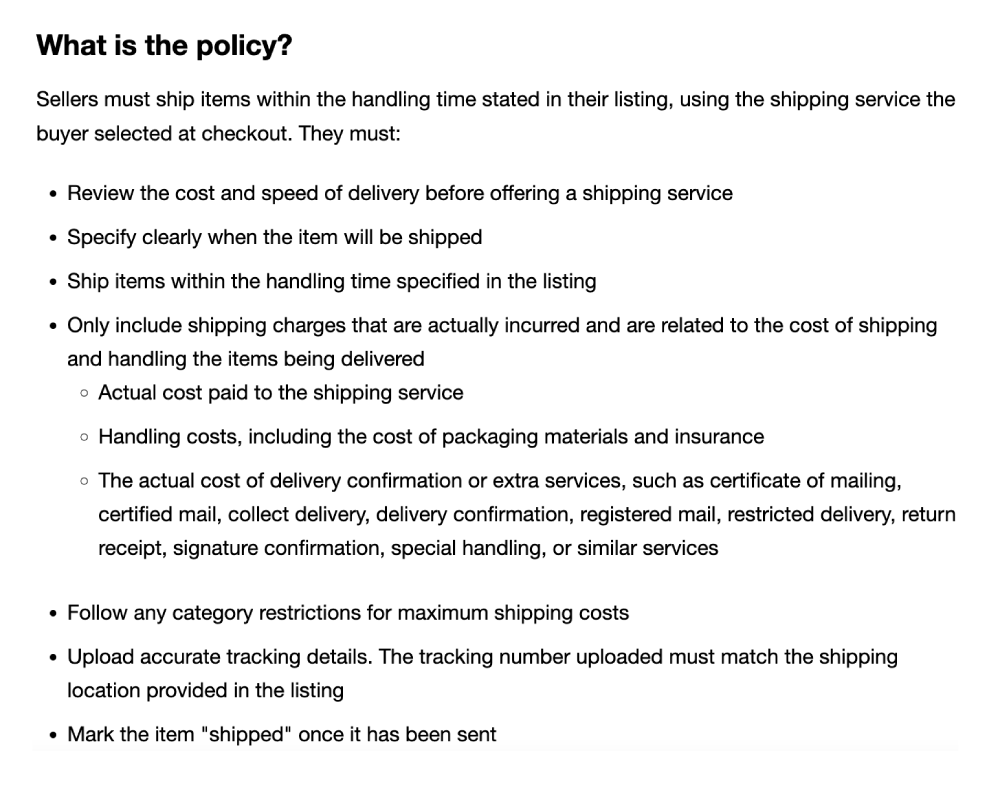
For instance, the sellers cannot use a slower shipping method than the one selected by the buyer. Also, they cannot include additional fees for packaging/handling when providing free shipping or delay shipping after a payout initiation notification gets received.
This policy helps protect seller performance and minimize defect rates to increase customer satisfaction by ensuring they meet their expectations.
Amazon
You cannot talk about eCommerce and fail to mention Amazon, the world’s largest online retailer.
The company is also the world’s largest marketplace and has earned the moniker “the everything store.”
Amazon has a detailed shipping policy that matches its size.
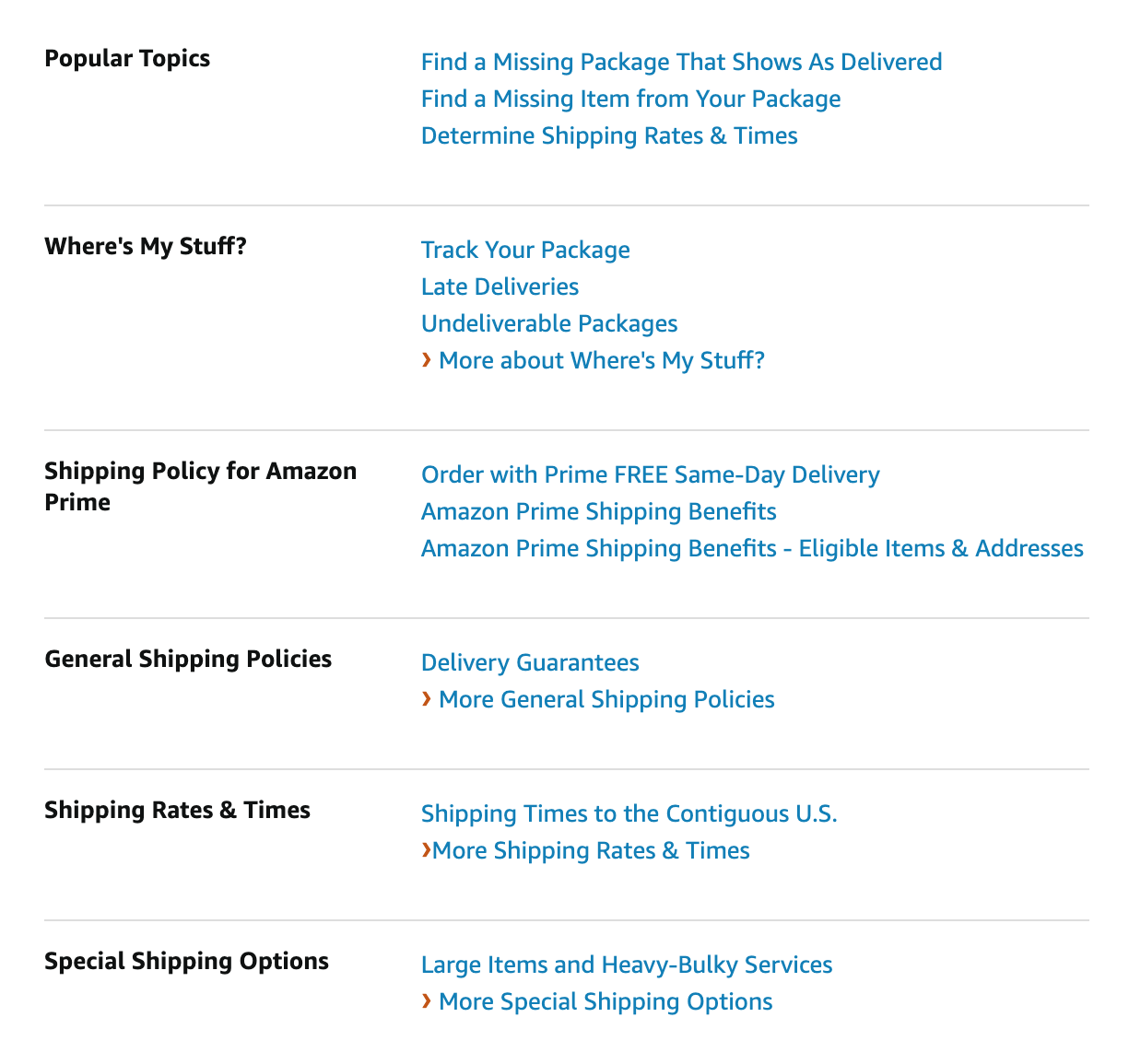
This policy cannot even fit on a single page. It has links to different sections of the document that explain the specific parts. Amazon Prime has a separate shipping policy that states the terms for same-day delivery.
Shopify
Like eBay, Shopify has a different operating model. It allows sellers to create storefronts for selling their merchandise, operating more like a website builder.
Therefore, the platform does not have a shipping policy because it does not sell goods directly. But it has documentation to explain how to create and add a shipping policy to your store.
Where to Display Your Shipping Policy
Having a detailed and simple-to-understand shipping policy is not enough. It is imperative to place the information or visible links to the document on several spots, including the following areas.
Website Footer
Most customers look for shipping information, privacy policies, money-back policies, etc., in the footer section. Take a look at this footer.
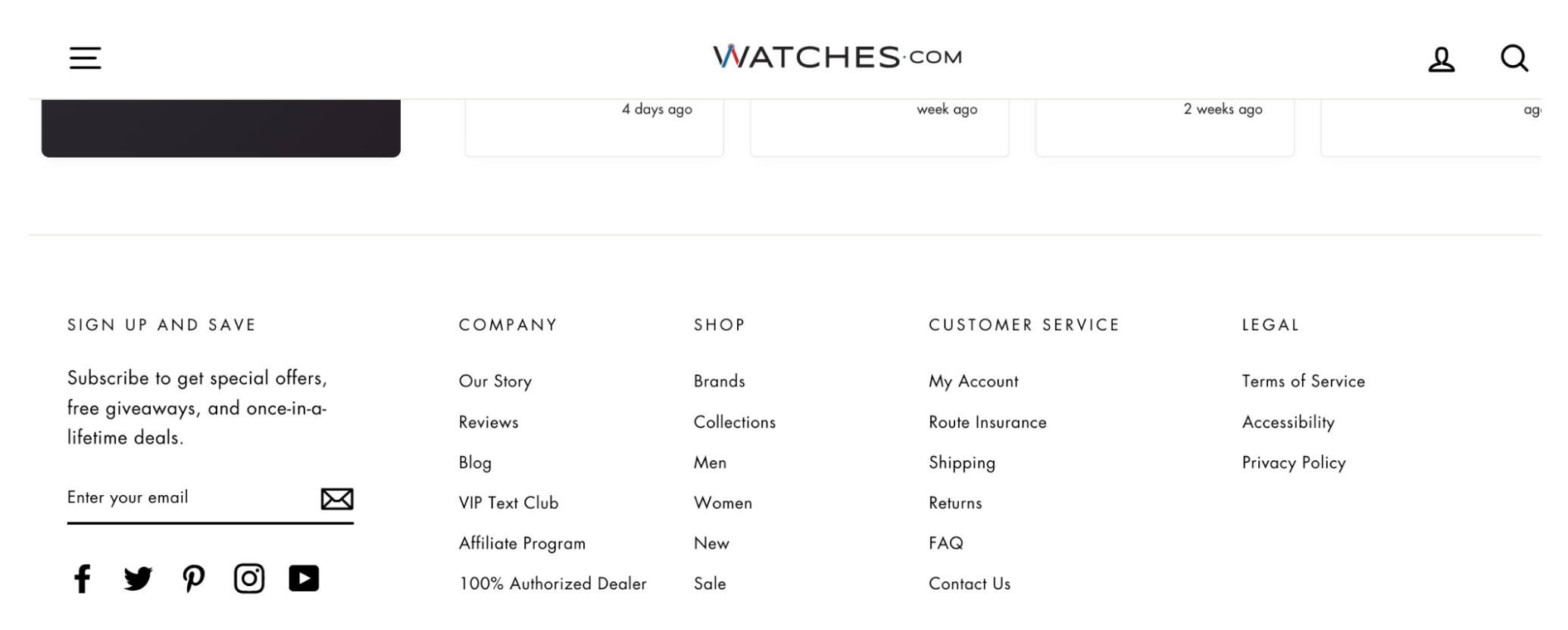
Announcement Bar
This spot might contain some animations and is best for displaying updates to the shipping policy. Most eCommerce websites placed COVID-19 shipping updates announcements on this section during the height of the pandemic because it interrupted global shipping.
Product Pages
Customers usually check the shipping costs before placing an order. Therefore, it is wise to display shipping info on the product pages.
This addition might increase sales conversions.
Shopping Cart
In addition to placing the policy on the product pages, you should add shipping information to the shopping cart.
It's seemingly integrated with our supercharged order tracking pages once Rush is installed.
This spot is convenient because it provides the crucial pricing information required before the customer checks out.

FAQs Page
You can implement the shipping policy as a set of questions instead of a page with large blocks of text. This strategy can make it easier to read through the terms and conditions. Here is an example from Organic Olivia.
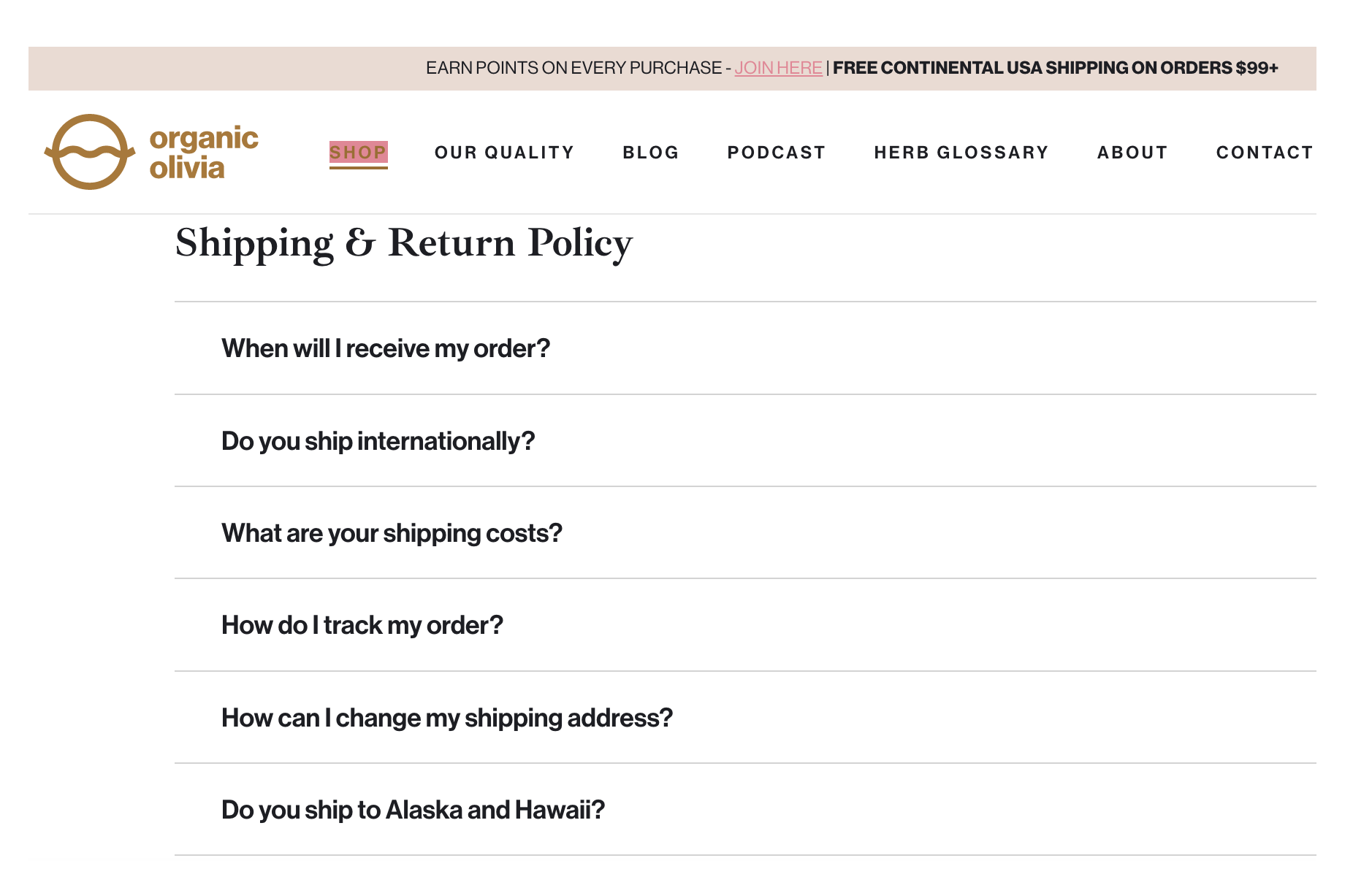
FAQs
We have covered enough about shipping policy templates, and now we’ll look at some of the pivotal questions that need clarification.
How Do You Write a Shipping Policy?
You can write it from scratch or use a template. The latter is better because it saves on time and effort. Either way, ensure the document is concise.
Is a Shipping Policy Required?
A shipping policy is not a legal requirement for any eCommerce business. However, it has numerous benefits, key among them being increasing sales, especially if you provide free or discounted shipping.
An online store with free/discounted shipping can get higher sales if it indicates this sales policy than one with the same deal but not displayed.
How Do I Add a Shipping Policy on Shopify?
What is not a shipping policy?
Any document that does not describe the terms and conditions for shipping/delivering products domestically or internationally is not a shipping policy.
Wrap Up
In conclusion, creating a shipping policy from scratch can be time-consuming. It is even more challenging if you have a complex eCommerce business like Amazon because you will have multiple shipping conditions to indicate.
However, a shipping policy template can simplify the task and ensure you don’t leave out any details.
That’s it for this article. If you have any questions or comments, leave a message in the chats section, and we’ll get back to you asap.
